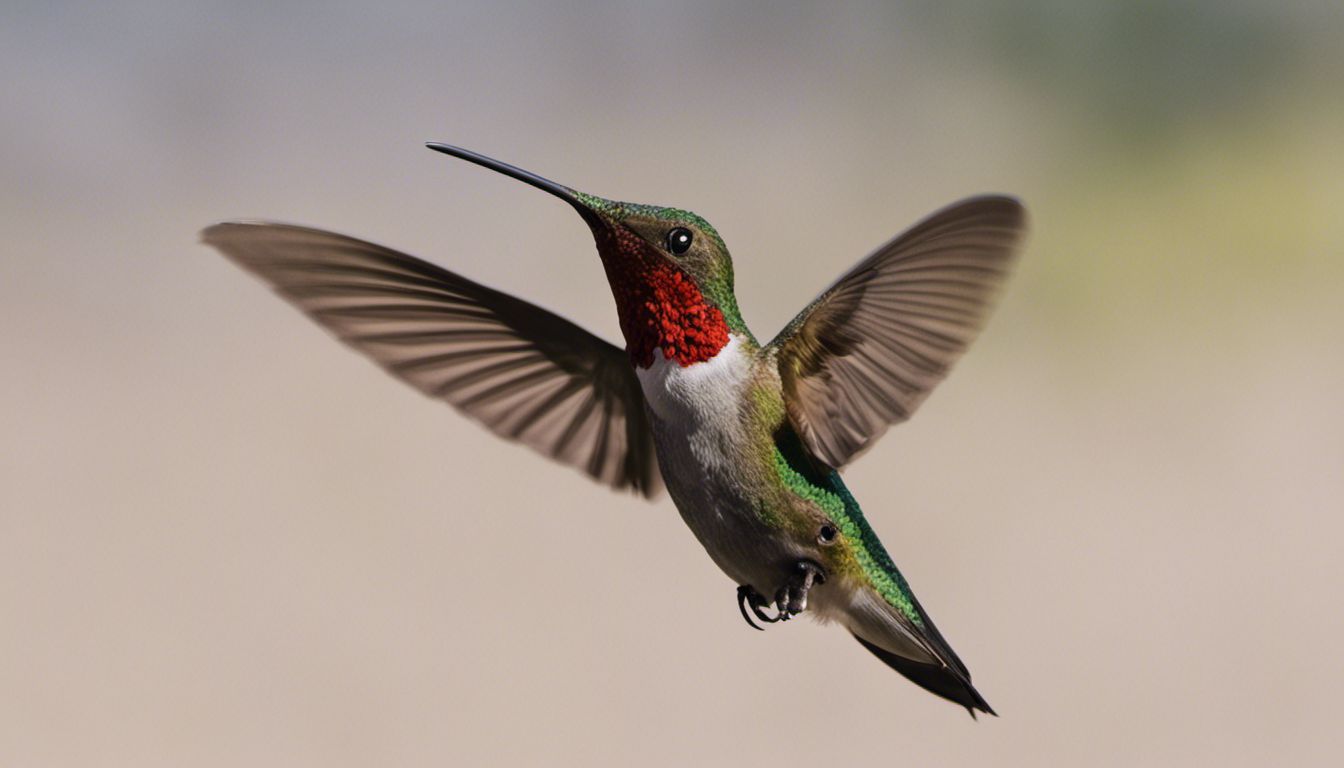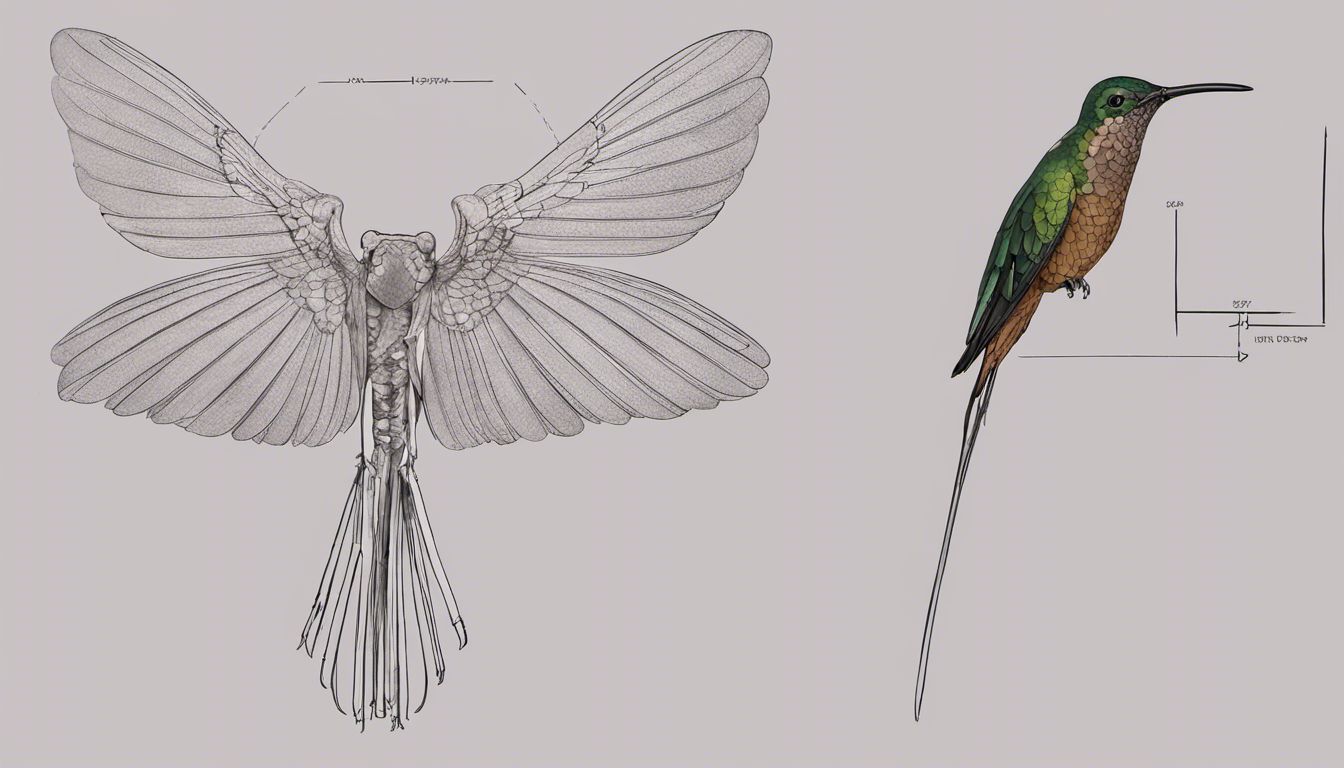Hummingbirds possess a unique ability to hover and maneuver in mid-air thanks to the specialized structure of their wings and an exceptional flight muscle ratio. This distinctive flight is made possible through intricate aerodynamics, a specialized skeletal structure, and a high-energy consumption optimized for their size and flight mechanics.
Here are the key takeaways regarding how hummingbirds fly, focusing on the structure of their flight:
– The Aerodynamics of Hummingbird Flight: Hummingbirds use a figure-8 wing movement that generates lift on both the downstroke and upstroke, enabling them to hover with precision.
– Hummingbird Wing and Skeletal Structure: Their wings are attached to the body only at the shoulder joint, which allows for a wide range of motion, and their lightweight bones offer the necessary support without compromising agility.
– The Energetics of Hummingbird Flight: Hummingbirds have an extremely high metabolism rate which provides them with the energy required for their rapid wing beats and hovering flight style. They consume energy-rich nectar to sustain this demanding energetic cost.
The Aerodynamics of Hummingbird Flight

Hummingbird aerodynamics are quite a marvel in the natural world, as these tiny birds exhibit some of the most sophisticated flight mechanics found amongst avian species. The figure-eight pattern of their wingbeats is central to their ability to hover in place and navigate with precision in all directions, including forward, backward, and even upside-down.
Here’s a snapshot of how the hummingbird aerodynamics contribute to their unique flight capabilities:
- The figure-eight wingbeat pattern of hummingbirds is a defining characteristic of their flight, enabling hovering with unparalleled stability.
- This flight pattern allows for lift generation on both the downstroke and upstroke, a feature not common in other bird species.
- Hummingbirds can fly in multiple directions, including backward and upside-down, due to their ability to rapidly change wing angle and stroke amplitude.
- The specific aerodynamics also allow for instantaneous velocity changes, giving them the skill to dart to and fro while foraging or escaping predators.
The sophisticated wing movements of hummingbirds undoubtedly showcase the elegance and complexity that nature can achieve in the realm of aerodynamics.
Hummingbird Wing and Skeletal Structure

The physiological design of hummingbirds plays a pivotal role in their flight capabilities, with particular aspects of their wing structure and skeletal anatomy standing out. Notably, the humerus bone is integral to their impressive aerial maneuverability.
Let’s delve into the components that enable hummingbirds to execute their precise movements in mid-air:
- The wings of a hummingbird are supported by a unique skeletal structure, which is optimized for flight agility and flexibility.
- Unlike many other birds, their wings connect to the body at the shoulder joint alone, allowing for a greater range of motion that is essential for complex aerial maneuvers.
- The humerus bone, which is relatively short and stout, serves as the main lever arm for wingbeats and is a critical structural component that supports high-frequency wing movement.
- This anatomical adaptation assists not just in hovering but also in providing the extraordinary ability to change direction rapidly, contributing to the bird’s renowned maneuverability in flight.
The combination of these physiological features is what allows hummingbirds to exhibit their unique flying patterns, with a level of control and precision that is unmatched in the avian world.
The Energetics of Hummingbird Flight

Hummingbirds are remarkable for their energy expenditure, necessary to sustain their rapid and acrobatic flying style. Their high-speed flight is fuelled by an incredibly fast metabolism and a diet primarily consisting of nectar, which provides the sugar needed for energy.
Explore the energetic demands of hummingbird flight and how they meet these demands:
- Hummingbirds have an extraordinarily high metabolism, among the fastest of any animal, to support the energy needs of their high-speed wing flapping.
- They consume nectar frequently throughout the day to meet their energy requirements, with nectar consumption being an essential part of their diet.
- Their bodies are fine-tuned to convert the sugars from nectar into immediate energy, aiding their incredible agility and flight proficiency.
- Despite their small size, hummingbirds can travel great distances and achieve impressive feats like migratory flights over the Gulf of Mexico, demonstrating their ability to sustain high-speed flight over extended periods.
The energy dynamics within these tiny creatures are optimized to support their bustling activity levels and are a testament to their evolutionary specialization for flight.

